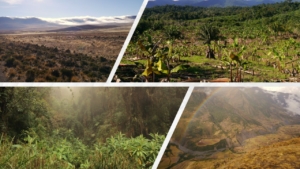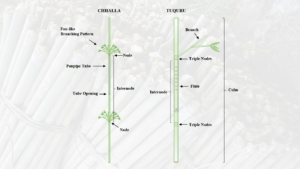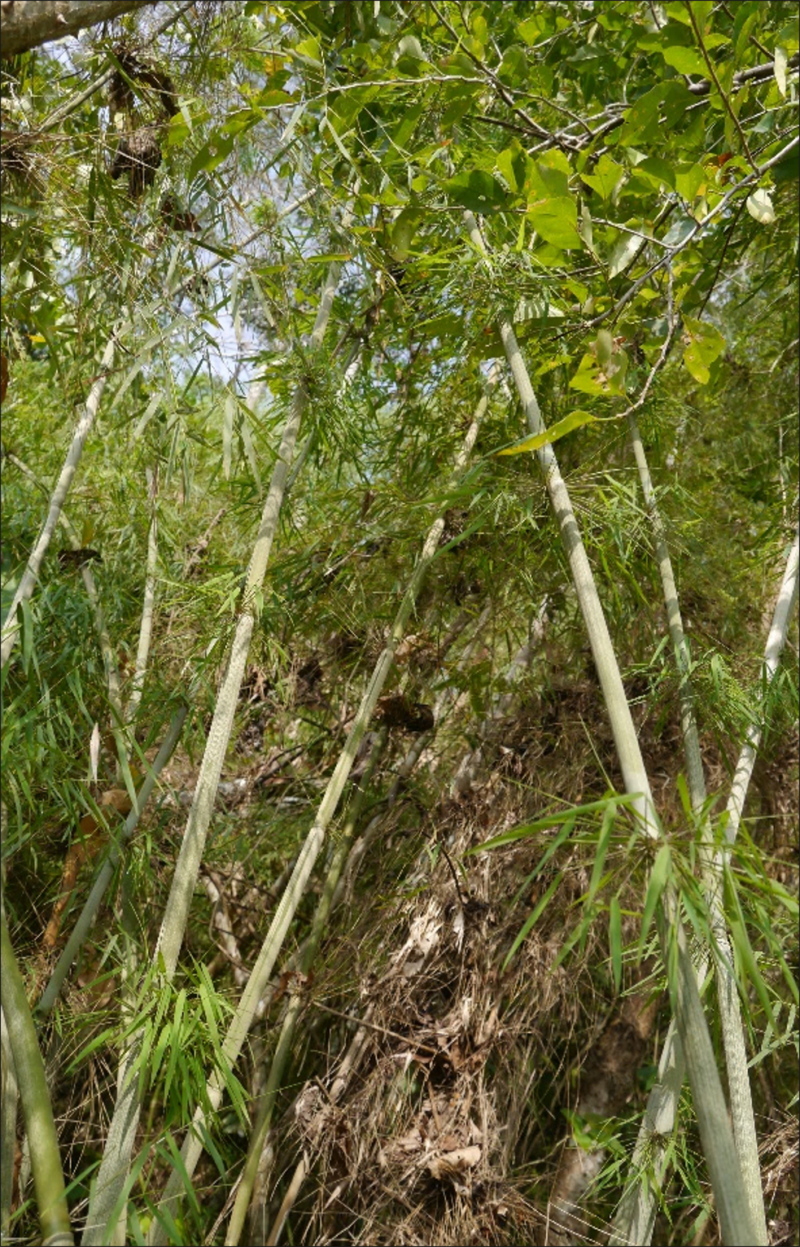by Sebastian Hachmeyer
My interdisciplinary research on the Musical Bamboos of the Bolivian Andes includes topics and approaches related to various (sub)disciplines and fields of study such as ethnomusicology and organology, plant ecology and phenology, geobotany and phytogeography, sustainability studies and natural resource management, ecological economics and political ecology, as well as anthropology of music and the environment. Inspired by ecomusicological and ecoorganological studies on natural materials and musical instruments (Allen 2023), the term “musical bamboos” expresses the use of native woody bamboos for wind instrument making in the Bolivian Andes. This short research report and related interactive Story Map introduce my research to the broader ecomusicological community and offer a preview of selected topics I deal with in my book project.
Figure 1: Ecosystems of La Paz Department (Photos by the Author)
Bolivia is a landlocked country in South America that, thanks to its diverse topography, is extremely biodiverse. The Andean highlands (altiplano) around Lake Titicaca are located over 4,000 meters above sea level. The eastern Andean slopes descend to the humid cloud forests of the yungas (between 3000 to 500 meters above sea level) and, further east, to the lowlands of the Amazon and Chaco (below 500 meters above sea level). My research sites are in the Aymara highlands (mainly La Paz Department), where bamboo-made flutes are made and played, and in the tropical yungas cloud forests and Andean Amazonian foothills, where native woody bamboos are sourced. The La Paz Department has different landscapes and ecosystems (Figure 1). In the top left picture, there are the highlands (Loayza province); in the bottom right picture, the dry Inter-Andean valleys (Muñecas province); in the bottom left picture, the cloud forests of the central yungas (Murillo province); and in the top right picture, the Andean Amazonian foothills of Alto Beni, with a banana plantation in front of primary Amazon rainforest (Sud Yungas province). (These and other photos are also available in the interactive Story Map)
In my PhD research (2015-2020), I took an interdisciplinary mixed-methods approach blending ethnomusicology, botany, biogeography, and ecomusicology. I employed sustainability as an analytical tool to consider how different musicultural, political, environmental, and economic factors influence and determine the use of woody bamboos in flute-making practices. I used both qualitative and quantitative methods, such as ethnography, species distribution models, and spatial analysis using geographic information systems. My goal was to advance environmental and musicultural knowledge about tropical bamboos used in highland flute making. I followed the bamboo from highland flute-making workshops to subtropical bamboo thickets (which alludes to the multi-sited ethnography by Marcus 1995) and traced the bamboos all the way back to the clumps (which alludes to the upstream geography by Gibson 2019).
Many highland flute makers in La Paz come from the Aymara village of Walata Grande. They are known as luriri in Aymara, which literally means “the ones who make.” They have specialized in making highland flutes and have monopolized almost all flute-making activities on the Bolivian highlands over the second half of the twentieth century (Borras 1995). Since the 1950s, the luriri have migrated to the urban metropolitan area of La Paz, established in most cases double residencies, and began to craft and sell flutes in central popular marketplaces on sidewalks and street stands known as qhatu in Aymara. I accompanied my flute maker friends in their everyday flute-making activities and spent valuable moments in their workshops. (See the photos in the interactive Story Map) Together we discussed the current dynamics in the Andean music culture and the future of Walata Grande as a specialized flute-making center. We critically assessed the conditions for a sustainable future of flute-making practices and shared thoughts about the current challenges in obtaining, sourcing, and collecting musical bamboos.
Figure 2: Diagram of Chhalla and Tuquru Bamboos (By the Author)
The two main musical bamboos used by highland flute makers in Bolivia are called chhalla and tuquru in Aymara (Figure 2). These local linguistic categories denote both the dried bamboos as well as the plants from which they derive, mainly several species from the Andean woody bamboo genera of Rhipidocladum and Aulonemia (some species of which are unknown and undescribed by botanists). Chhalla is used for making a variety of panpipes such as siku, while tuquru is used to make a variety of vertical and transverse flutes such as qina, phala, pinkillu and musiñu (Figure 3). Within these local bamboo categories of chhalla and tuquru, there are different types and variants with different characteristics. Highland flute makers use at least six different chhalla types, which are named after the recognized sourcing regions in the yungas cloud forest ecoregion. They furthermore divide between three distinct tuquru types (with some subdivisions), also growing in different parts of the Bolivian yungas (see the Story Map for interactive information on bamboo types, sourcing regions, and species distributions). These types and variants of chhalla panpipe and tuquru flute bamboos differ in tube length and diameter, wall thickness, internode length, texture, weight, and other features. Bamboo selection is based on aesthetic, acoustic, and morphological aspects, but it varies significantly between flute makers and flute-making contexts.
These Andean woody bamboos are perennial plants, which means that they have life cycles longer than two years. Moreover, they are monocarpic plants that die after flowering. Andean woody bamboos such as chhalla and tuquru exhibit gregarious flowering and mast seeding, in which all individuals of the same cohort synchronize and simultaneously flower and set seed. Botanists usually reconstruct flowering events with archived herbarium specimens (Guerrero 2013). During my fieldwork, I employed a similar method for the musical bamboos of the Bolivian Andes. I linked my own field observations of the biological life cycle stages (phenophases) in 2018 with local flute maker and bamboo collector knowledge, and I reconstructed flowering events from herbarium specimens where available. Analyzing the musical bamboos from such a phenological perspective helps to better understand the ecological implications for Aymara flute makers in terms of material availability. It shows how highland flute making — in addition to musicultural frames of musical seasonality where specific musical instruments and genres were played according to distinct climatic and festive seasons (Buechler 1980) — is ecologically framed by the phenology of musical bamboos. One can observe a clear trend of time-staggered flowering events of different musical bamboo species so that the mass mortality of one species is followed by a flowering event of another. In other words, if one species senesces, another is about to become ready for collection (see the Story Map for more detail).
Figure 3: Photos of some Altiplano Bamboo Flutes (Photos by the Author)
In this ecological context, best collection practices depend on the lignification of bamboos, which is their hardening process. Many bamboo collectors told me that chhalla and tuquru bamboos harden approximately half-way through their life cycles. The best gathering season is the dry season, when rains diminish and the bamboos’ starch content decreases (which means fewer insect pests in the culm). Over the rainy season, new culms grow and propagate from the clumping rhizome. If done correctly, bamboo collectors can harvest clumps over several years until the bamboos finally decay. Understanding the uneven age structure of clumps is key for a sustainable harvest. I learned from bamboo collectors that mature and old culms are situated in the clump’s center, while immature culms (which still need to lignify) grow in its periphery. Experienced collectors identify the center, cut a tunnel-like entrance into the clump, remove mature and old culms, and sometimes even leave mature culms in the clumps that support the growth of still lignifying immature once (the Story Map provides diagrams of this best collection practice).
Woody bamboos have an extremely rapid primary growth but no secondary growth, and culms grow out of the forest soil with their final diameter. To guarantee reproduction, it is critical that culms are left behind in the clumps so that they can finally flower and set seed. Based on this ecological panorama, one can argue that highland flute making, through recurring bamboo material availability cycles, is largely framed by the ecology and phenological patterns of musical bamboos. Flute makers developed hording practices to bridge natural scarcity periods and diversified the use of different bamboo species with time-staggered biological life cycles and phenophases to additionally shorten these ecologically induced cyclic material shortages. On a more general level, they developed highly specialized knowledge about the biogeography and ecology of bamboos and the practice of bamboo gathering. Such ecological and environmental knowledges are on the verge of being forgotten today by new generations of flute makers who are no longer involved in bamboo collection. Their parents and grandparents collected bamboos themselves with different ecological and economic rationales; for them, resource dilemmas were frequent, and the sustainability challenge was the management of bamboos as a common pool resource, which resulted in the sustainable harvesting method described above.
Photo: Chhalla Bamboo in Natural Habitat (Photo by the Author)
By the turn of the millennium, flute makers had gradually transferred bamboo sourcing to external actors, a type of outsourcing, where middlemen regard bamboos as commodities and clear-cut clumps to increase their profit margin. In some cases, bamboos are collected unsustainably in relation to their capacity of natural reproduction. Therefore, bamboo resources are overexploited. Extinctions at population level in some recognized sourcing regions are consequences of this extractivist collection method, which I have linked to shifting contexts of flute making on the highlands in relation to expanding tourism-oriented commerce (Hachmeyer 2020). Additionally, bamboos are threatened by anthropogenic destruction of viable habitats, which is linked to deforestation and the expansion of the agricultural frontier in the Bolivian yungas cloud forests and Andean-Amazonian foothills. The Story Map contains further information on deforestation in Bolivia and the impact on musical bamboo ecology and geographic distributions. These are two newer limitations to bamboo availability and new sustainability challenges for future generations of flute makers.
The question of sustainability in flute making as it relates to the use of native woody bamboos is a complex issue. First, it depends on the ecological and environmental knowledges linked to musical bamboos. Knowledge transmission is key in this regard. Second, deforestation is induced by powerful national and international actors, while flute makers themselves have little power and autonomy in confronting this issue. A strong advocacy is needed to address these issues politically. If deforestation expands, it will increase supply-induced scarcities in the future, when climate change impacts on musical bamboos must also be considered (see Hachmeyer Forthcoming). Third, overexploitation in recognized sourcing regions threatens the reproduction of musical bamboos. Reasons are manifold and include the commodification of bamboos, middleman trading, the loss of sustainable gathering knowledge, tourist commerce, shifting bamboo demands, and extractivist collection practices, among others. However, besides all these critical points, one must also consider that tourist commerce, which produces some income for precarious and informally working flute makers, also contributed to sustaining more traditional highland flute-making practices over time: flute makers, in a kind of dual economy, usually cover the demands of different flute-making and musical contexts.
Photo: Tuquru Bamboo in Natural Habitat (Photo by the Author)
Regarding the development of sustainability research in ecomusicology, I am currently working towards implementing more transdisciplinary research processes (e.g., Padmanabhan 2019; Allen 2023). In this context, important principles for transdisciplinary sustainability research are problem-based approaches and normative claims. My ecomusicological research and advocacy has so far been centered on amplifying knowledge for understanding sustainability challenges to highland flute making and bamboo sourcing in particular and on the relationships between musical culture and the environment more generally. My future endeavors are directed towards working with some flute makers and bamboo collectors to develop mutual value consensuses, specific criteria for sustainability in highland flute making and bamboo sourcing, and practical and feasible action plans for confronting specific sustainability challenges. As such, this work may be characterized as “applied ecomusicology,” as Allen et al. (2023) have done. This two-year research project will be funded by the German Research Foundation (DFG) within the Walter Benjamin program (project number: 530324575). Activities and outputs of this project will be announced in my new research blog: www.musical-bamboos.com.
References
Allen, Aaron S. 2023. “Ecoörganology: Toward the Ecological Study of Musical Instruments.” In Sounds, Ecologies, Musics, edited by Jeff Todd Titon and Aaron S. Allen, 17–39. New York: Oxford University Press.
Allen, Aaron S., Taylor Leapaldt, Mark Pedelty, and Jeff Todd Titon. 2023. “The Sound Commons and Applied Ecomusicologies.” In The Routledge Companion to Applied Musicology, edited by Christopher Dromey, 143–59. Routledge.
Borras, Gérard. 1995. “Les Aerophones Traditionnels Aymaras dans le Département de La Paz (Bolivie).” PhD thesis, University of Toulouse.
Buechler, Hans. 1980. The Masked Media: Aymara Fiestas and Social Interaction in the Bolivian Highlands. The Hague: Mounton Publishers.
Gibson, Chris. 2019. “A Sound Track to Ecological Crisis: Tracing Guitars All the Way Back to the Tree.” Popular Music, 38(2): 183-203.
Guerreiro, Carolina. 2013. “Flowering Cycles of Woody Bamboos Native to Southern South America.” Journal of Plant Research, 127(2): 307-313.
Hachmeyer, Sebastian. 2020. “Musical Bamboos, Environmental Sustainability, and the Limitations of Cultural Safeguarding”. Lecture and Workshop given at the SDG Graduate School Performing Sustainability: Cultures and Development in West Africa of the Centre for World Music, University of Hildesheim, 06-07.10.2020.
Hachmeyer, Sebastian. Forthcoming. “Climate Change and the Musical Bamboos of the Bolivian Andes: Habitat Loss due to Deforestation and Future Distribution in Biodiverse Yungas Cloud Forests.” In Music and Climate Change: Artistic Action in Times of Crisis conference proceedings, edited by Sarah Beimdieke and Julian Caskel.
Marcus, George. 1995. “Ethnography in/of the World System: The Emergence of Multi-Sited Ethnography.” Annual Review of Anthropology, 24(1): 95-117.
Padmanabhan, Martina. 2019. Transdisciplinary Research and Sustainability: Collaboration, Innovation, and Transformation. Routledge: London.




